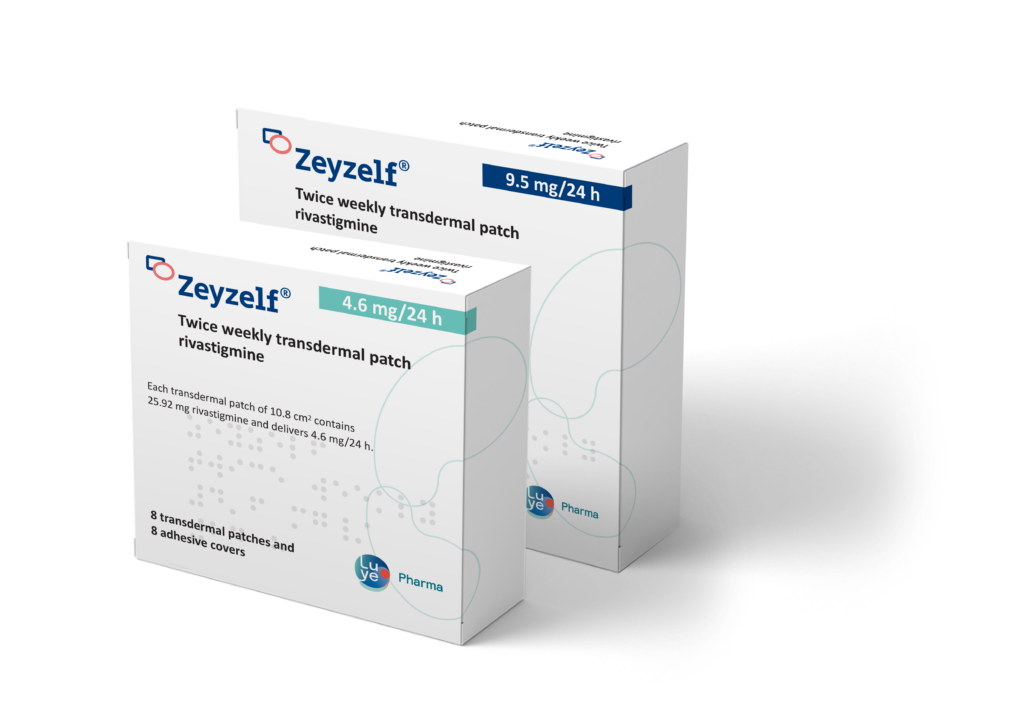Alzheimer’s disease treatment can help reduce symptoms and lessen the care burden for patients and their caregivers
September 2023: Zeyzelf® twice weekly rivastigmine transdermal patch is for the symptomatic treatment of mild to moderately severe Alzheimer’s dementia and it is the first ever patch to be launched in the UK that does not need daily application.
A study showed Zeyzelf® twice weekly is bioequivalent to daily rivastigmine patches,[i] but because it only has to be applied twice weekly, it can be easier to administer and help the patient and caregiver maintain adherence.[ii] Zeyzelf® twice weekly is also 52% less expensive than some rivastigmine patches.[iii]
In elderly patients, transdermal delivery of rivastigmine may have advantages over other delivery routes, such as oral medications, as it provides ease of use for the patient and carer, gives greater adherence to prescribed regimens and has less risk of toxicity and ‘dose dumping’.[iv] Transdermal delivery of rivastigmine, which works by blocking certain enzymes in the brain to help reduce symptoms, is also useful when elderly patients are unable to tolerate or unwilling to swallow tablets.[v]
In a comparative study, Zeyzelf® twice weekly demonstrated better adhesion properties than the daily rivastigmine patch – in 95% of patients there was satisfactory adhesion, compared to 67% with the comparison patch.[vi] Skin adhesion is one of the most important functional properties for a transdermal patch and is critical for the safety, efficacy and quality of the patch.[vii] Poor adhesion can lead to improper dosing, with additional patches having to be used, which takes up more carer and healthcare professional time. [vii]
There are currently 900,000 people with dementia in the UK, which is projected to rise to 1million by 2025 and nearly 1.6million in 2040.[viii] Alzheimer’s disease, which affects multiple brain functions, is the most common form of dementia and it is a progressive condition, with symptoms developing gradually over many years and eventually becoming more severe.[ix]

The cost of dementia to the UK is currently £34.7billion annually – an average cost of £32,000 per person, two-thirds of which is paid by the patients and their families either in unpaid care of private social care.[x] Treatments such as Zeyzelf® which can be easier to administer and improve compliance can help reduce this care burden.
Zeyzelf® twice weekly is launched by Luye Pharma Ltd, which specialises in diseases of the central nervous system (CNS). The company believes Zeyzelf® twice weekly will offer a significant development in the treatment of Alzheimer’s and it has been well received by patients, clinicians and carers in Spain, where the product launched last year.
Zeyzelf® twice weekly patches are an important development in the treatment of Alzheimer’s dementia, where a small change can make a big difference. We know that transdermal delivery can be advantageous to both patients and carers and by having a patch that only has to be applied twice a week, rather than daily, will significantly reduce the carer burden and also potentially improve compliance. Healthcare professionals and carers all recognise that compliance is a major issue in the treatment of Alzheimer’s and Luye has launched Zeyzelf® twice weekly to help meet this unmet need. The product has been incredibly well received in Spain and is being widely used with patients and we hope this will be the same in the UK.
Andy Farrant, General Manager of Luye Pharma Ltd
ABOUT ZEYZELF®
Zeyzelf® twice weekly transdermal patches are for the treatment of mild to moderately severe Alzheimer’s dementia. The active substance of Zeyzelf® twice weekly is rivastigmine. Rivastigmine belongs to a class of substances called cholinesterase inhibitors. In patients with Alzheimer’s dementia, certain nerve cells die in the brain, resulting in low levels of the neurotransmitter acetylcholine (a substance that allows nerve cells to communicate with each other). Rivastigmine works by blocking the enzymes that break down acetylcholine: acetylcholinesterase and butyrylcholinesterase. By blocking these enzymes, rivastigmine allows levels of acetylcholine to be increased in the brain, helping to reduce the symptoms of Alzheimer’s.
Zeyzelf® twice weekly patches are available in 4.6mg or 9.5mg dose strengths.
Read more about Zeyzelf® twice weekly.
[i] Zeyzelf® twice weekly is bioequivalent to the originator Exelon daily transdermal patch (Schurad B et al. Current Alzheimer Research, 2022, 19, 541-553)
[ii] Zeyzelf® twice weekly transdermal patch, Summary of Product Characteristics, Luye Pharma Ltd. September 2023
[iii] Zeyzelf® twice weekly patches provides a considerable cost saving compared to the daily transdermal patch Exelon, with >50% cost savings. Source: NHSBSA Drug Tariff (England and Wales). September 2023
[iv] Dose dumping is a phenomenon of drug metabolism which can cause the premature and exaggerated release of a drug, which can greatly increase the concentration of a drug in the body and thereby cause adverse events or even drug-induced toxicity. Dose dumping is most commonly seen in drugs taken orally (by mouth) and digested in the gastrointestinal tract
[v] Vadivelu N, Hines R L. Clin Interv Aging, 2008 Sep; 3(3): 421-430
[vi] In a study comparing the twice weekly Zeyzelf® patch and Exelon daily patch, Zeyzelf® showed better adhesion properties than the Exelon patch despite the longer dosing intervals (Schurad B et al. Current Alzheimer Research, 2022, 19, 541-553). The EMA (European Medicines Agency) Guideline defines satisfactory adhesion as ≥ 90% of area that remained adhered at assessment. Assessments were taken 24h post application of the patches. Available online at: https://www.ema.europa.eu/en/documents/scientific-guideline/guideline-pharmacokinetic-clinical-evaluation-modified-release-dosage-forms_en.pdf
[vii] Wokovich A M et al. Eur J Pharm Biopharm. 2006 Aug;64(1):1-8
[viii] Alzheimer’s Society. https://www.alzheimers.org.uk/blog/how-many-people-have-dementia-uk#:~:text=Research%20conducted%20shows%20that%2C%20in,the%20current%20rate%20of%20prevalence (accessed September 2023)
[ix] NHS. https://www.nhs.uk/conditions/alzheimers-disease/ (accessed September 2023)
[x] Alzheimer’s Society. How much does dementia care cost. https://www.alzheimers.org.uk/blog/how-much-does-dementia-care-cost (accessed September 2023)

